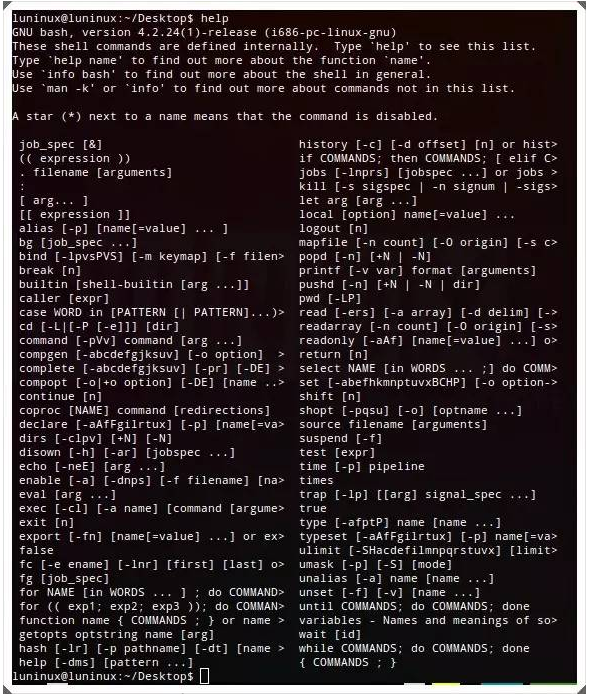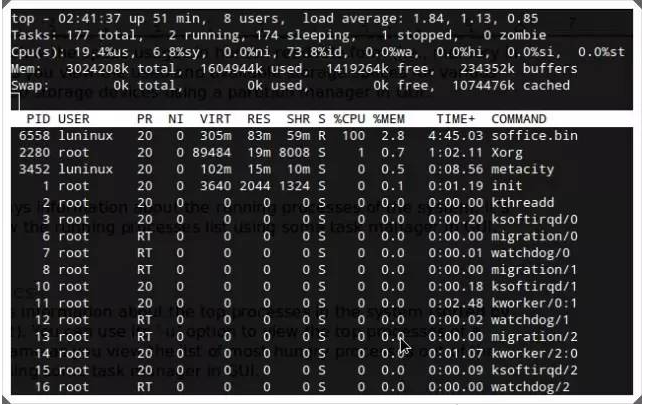
Commands are instructions for the computer to perform tasks. You can use commands to shut down the computer, or list the files in the current directory, or the contents of the current text, or display a message on the screen.
If you are a newbie and trying to use the command line interface, we have collected a variety of basic Linux commands for you to learn and help you complete various tasks in various Linux distributions. Although it is not very detailed, it is very useful for Linux beginners, ordinary users, or administrators.
ls will list the contents (files or folders) of the current working directory, just like you open a folder in the GUI to see the contents.

mkdir common a new directory

pwd displays the current working directory

4.cd – Change Directory
For the session currently running in the terminal, cd sets the given folder (or directory) to the current working directory.

5.rmdir – Remove Directory
rmdir Delete the given directory.

6.rm – Remove
rm will delete the given file or folder. You can use rm -r to delete the folder recursively

7.cp – Copy
The cp command copies files or folders. You can use the cp -r option to copy folders recursively.

8.mv – MoVe
The mv command moves files or folders. If the file or folder exists in the current working directory, it can also rename the file or folder.

9.cat – concatenate and print files
cat is used to view file contents on standard output (monitor or screen).

10.tail – print TAIL (from last) >
tail displays the last 10 lines of a given file on the standard output by default. You can use tail -n N to specify the last N lines of the file to be displayed on the standard output.

11.less – print LESS
less Print file contents by page or window. Very useful and efficient when viewing large files containing large amounts of text data. You can use Ctrl F to page forward and Ctrl B to page backward.

12.grep
grep "" Search for the specified string in the given file. grep -i "" will ignore the case of the string when searching, while grep -r "" will recursively search the specified string in the files in the current working directory.

13.Find
This command will search for files matching the conditions in the given location. You can use the -name option of find -name for a case-sensitive search, and find -iname for a case-insensitive search.
“
find -iname
”

14.tar
The tar command can create, view and extract tar compressed files. tar -cvf is to create the corresponding compressed file, tar -tvf is to view the corresponding compressed file, and tar -xvf is to extract the corresponding compressed file.

15.gzip
The gzip command creates and extracts gzip compressed files. You can also use gzip -d to extract compressed files.

16.unzip
unzip Decompress gzip files. Before decompressing, you can use the unzip -l command to view the file contents.

17.help
--help will list all available commands in the terminal. You can use the -h or -help option of any command to view the specific usage of the command.

18.whatis – What is this command
whatis will describe the given command in a single line.

19.man – Manual
man displays a man page for the given command.

20.exit
exit is used to end the current terminal session.

21.ping
ping Pings the remote host (server) by sending data packets, which is commonly used to detect network connections and server status.

22.who – Who Is logged in
who can list the currently logged in usernames.

23.su – Switch User
su is used to switch between different users. Superusers can switch to other users even without using a password.

24.uname
uname will display important information about the system, such as kernel name, host name, kernel version, processor type, etc. Use uname -a to view all information.

25.free – Free memory
free will display the system's free memory, occupied memory, available swap memory and other information. free -m will convert the units in the result into KB, while free -g will convert into GB.

26.df – Disk space Free
df View the disk usage in the file system – the used and available storage space of the hard disk and other storage devices. You can use df -h to display the results in a human-readable format.

27.ps – ProcesseS
ps displays the running process of the system.

28.Top – TOP processes
The top command will by default display processes that occupy a large amount of CPU usage. You can use top -u to view a user's CPU usage ranking.

29.shutdown
shutdown is used to shut down the computer, and shutdown -r is used to restart the computer.
The above is the detailed content of 29 Linux commands you must know. For more information, please follow other related articles on the PHP Chinese website!




